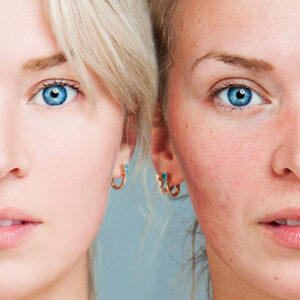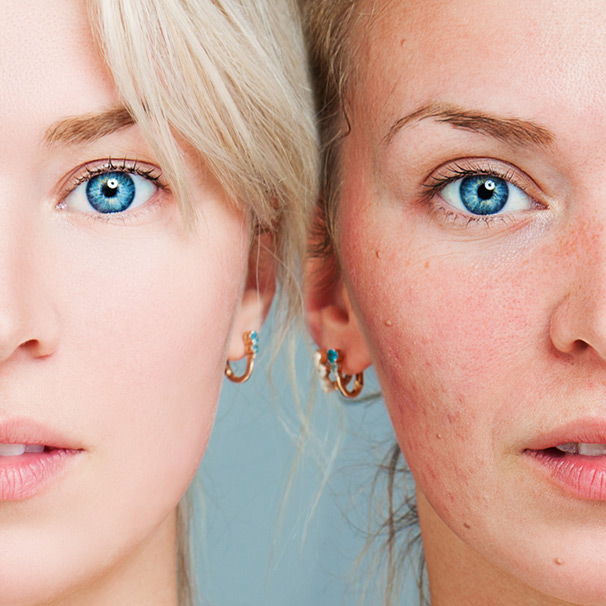Acne Scars
Years after outgrowing adolescent acne, the aftermath acne scars persist. Advances in acne therapy and dermatologic surgery have made it unnecessary for acne patients, both current and past to endure acne scarring.
An Ounce of Prevention
Prevention may sound like a glib answer for how to handle acne scars. But since an estimated ten million Americans become scarred to some extent by acne each year, prevention is the absolute best solution.
Who will develop acne scars and how severe will scarring be? Short of a crystal ball, much of that is left to chance. What we do know is that genetics plays a definite role in the likelihood of acne severity and consequent scar formation. Also, acne severity has been linked to a more severe form of scarring later in adolescence or adulthood.
Because 95% of acne patients will develop scarring to some degree, the earlier that treatment appropriate for the severity of the outbreak is initiated, the better the odds are that scar formation will be mild. Delaying acne therapy by 3 or more years is likely to increase one's risk of more significant acne scarring.
For the lucky majority, acne scarring is a minor annoyance, difficult for others to visualize. For others, acne scarring can cause devastating long-term emotional suffering in its victims. Teens may deal with depression, become withdrawn and lose self-confidence. In fact, acne scarring has been cited as a risk factor for male suicide.
Newer acne therapies make it needless for anyone to suffer from acne or go on to form scars. Early medical intervention is key to preventing unnecessary disfigurement. While this doesn't mean that everyone suffering a single blemish should rush to schedule an appointment with a dermatologist, I can't stress enough that acne unresponsive to OTC therapy options should be evaluated by a specialist.
I lost count long ago of the number of acne patients returning for their initial 6 to 8-week follow-up concerned about their new acne scars when in actuality there wasn't a scar in sight. What they were really noticing was color change. This post inflammatory hyperpigmentation (PIH) is not an acne scar. It is the normal remnant of the skin's inflammatory process.
For those with pale skin tones, this aftermath color change is usually pink, red or purple in color. Patients with darker skin tones may notice brown or black spots where their acne once was. PIH can fade unassisted. Unfortunately, the darker the PIH, the longer it may take to resolve. It may also require some intervention in order to hasten the process. While PIH is not a true scar, when it lasts past a year, it certainly seems like a permanent problem.
For areas that are brown in nature, the use of a hydroquinone-based bleach may be incorporated into an acne and skincare regimen. Prescription blends of hydroquinone and glycolic acid bleaches are highly effective in resolving undesirable skin discoloration.
Sun avoidance is crucial for many reasons, but when waiting out the fade-game, an oil-free, oil-reducing sunscreen is important. Ultraviolet light will darken the skin, preferentially darkening areas of abnormal discoloration. Always include an oil free sunscreen into your PIH regimen like.
Sun protection prevents this process, allowing bleaching treatments to work without interruption. A great option that can double as your foundation for the day is DERMAdoctor DD Cream Dermatologically Defining BB Cream SPF 30.
Cause and Effect
As an acne cyst forms, the neck of the sebaceous gland expands, filling with bacteria, cells and sebum that are unable to pass through to the skin's surface. Eventually the cyst ruptures this "foreign matter" deep within the dermis, which is quickly attacked by white blood cells responsible for fighting infection.
All acne scars are not alike. A forceful inflammatory response can have two results. The most common outcome is loss of tissue as collagen is destroyed. Skin overlying the collapse of the area is provided no support and a soft saucer-shaped depression (aka pock mark) or jagged ice pick scar is formed. This is more typical on the face and is seen in both men and women.
Less frequently excessive scar tissue (keloid) is formed as fibroblasts (the dermal cells which produce collagen) are triggered. This is more commonly seen on the male torso.
Patients are often surprised to discover that another skin change is in fact a form of acne scarring. Tiny firm white bumps surrounding hair follicles on the upper arms or upper torso are known as follicular macular atrophy. These scars can last indefinitely.
Aging can affect scar visibility. After the age of 40, 1% of the dermal collagen is lost annually. With this additional loss of collagen combined with reduced skin tone, scars can become far more noticeable. Acne Scar Treatments Nobody wants to miss out on the "best" treatment. But when it comes to treating acne scars, there is often no single "best" solution that applies to an individual or to every acne scar. Differences in location, depth, size and number of scars all affect treatment decisions. What is your perception of the scars? Do they cause great anxiety or is this something that you'd simply like to improve if possible? These questions along with cost, your expectations and the amount of effort you plan to devote to the treatment will also be factored into the decision making by the physician.
Luckily there are a number of new procedures now available that compliment or surpass previous scar revision techniques. Individually designing a program aimed at the patient's unique situation will help maximize improvement.
Non-ablative lasers trigger changes within the dermis without injuring the epidermis. They are the "lunchtime" form of laser therapy. Smoothbeam, Pixel, Fraxel and Erbium lasers may be used. Smoothbeam targets and heats the sebaceous gland, helping reduce sebum and acne formation. Heating the collagen helps tighten the dermis, resulting in less visible scarring.
Another option is the yellow pulse dye laser. The yellow light laser also helps treat keloidal scars, flattening and reducing redness as well as helping control itching of the raised scar.
A topical anesthetic cream is applied about an hour before the procedure. The surface of the skin is cooled to prevent the laser from damaging the epidermis. A patient will feel both the cold spray as well as some amount of stinging and heat during the session. The application of the topical anesthetic makes this tolerable. The procedure takes about an hour. Typically, three sessions a month apart are performed.
Filler Substances
Filler substances are best used for shallow, saucer-shaped acne scars. The market has seen an increase in the number and ever improving quality of filler substances used to help "plump up" acne scars. Restylane, Radiesse, Perlane and Juvederm are possible options.
Fat transplantation utilizes a patient's own fat removed by a small liposuction cannula, prepared and reinjected into the dermal defect. While none of these methods are permanent, results tend to last between 3 and 6 months.
Not interested in filler injections? Consider use of DERMAdoctor Wrinkle Revenge Ultimate Hyaluronic Serum which supports the skin's own production of natural filler.
Punch Excision
Ice pick acne scars have hard, irregular jagged borders and often the depth is irregular as well. Simple excision of these scars with a sutured closure allows the dermatologist to bring the dermis back together, get rid of the ragged margins and close the area with a fine, uniform line.
The tiny linear scar may be allowed to fade on its own or the procedure may be performed before a more generalized resurfacing is performed such as dermabrasion, microdermabrasion, chemical peel or laser resurfacing.
Subcision
In this procedure the dermatologist undermines the acne scar with a sharp instrument such as a tiny scalpel or needle. Subcision helps break fibrous bands of scar tissue that are creating tension between the epidermis and deeper structures and also helps induce new collagen formation.
Chemical Peels
A chemical peel involves the application of a high potency acid upon the skin. The more potent the acid, the deeper the penetration into the skin. Personally, I find this more beneficial for post inflammatory skin color changes and the most minor of acne scars. For at home use, DERMAdoctor Physical Chemistry Facial Microdermabrasion & Multiacid Chemical Peel provides both chemical peel and microdermabrasion action.
Topicals for Atrophic Scars
Everyone always wants to know what topicals can help acne scars. Anything that has been shown to help support dermal collagen bundle and hyaluronic acid may be useful. These are certainly options that I encourage those with acne scars to take. I do think that the reality is that a procedure is going to maximize your results, whether done alone or incorporated with a topical agent.
Keloid Scar Therapy
Keloids are never easy to treat. However, a variety of options continue to come to the market. Pressure dressings and massage may help flatten some keloids but is not considered a terribly effective form of treatment. Silicone based topicals are an option to help reduce keloid thickness and discomfort. Steroid creams, injections and impregnated tapes can also be beneficial for treating keloidal scars. Cortisone helps shrink thickened, raised fibrous scar tissue. The pulse dye yellow light laser as mentioned above is useful in keloid therapy. Finally, Interferon injections can help soften a keloid and smooth it out.
Acne scarring is no longer a problem without a solution. All of the techniques I described have become invaluable treatments for patients seeking to eradicate acne scarring. But never forget, scarring is preventable. Don't put off acne therapy. The earlier it's dealt with, the less likely acne scars will be in your future. Prevention is the best and most effective form of treatment.
Audrey Kunin, M.D.
This content is sponsored by DERMAdoctor. The author receives compensation for its creation. All content is the legal copyright of DERMAdoctor, Inc, and it may not be used, reprinted, or published without written consent. The information provided is for entertainment purposes only and is not intended to provide medical, legal or other professional advice.



Do you have any recommendations as to what avenue to take for moisture without all the oily residue that happens when I use oils. Thanks